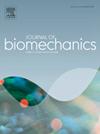Time course of Quadriceps thickness changes over six months post-anterior cruciate ligament reconstruction: Unveiling critical impairments in vastii muscles
IF 2.4
3区 医学
Q3 BIOPHYSICS
引用次数: 0
Abstract
Vastii muscle adaptation caused by Quadriceps weakness observed after an Anterior Cruciate Ligament reconstruction (ACLr) remain debatable. We described the time course of changes in Quadriceps thickness, strength, and thigh circumference over six months following an ACLr. Quadriceps thicknesses, Quadriceps strength, and thigh circumference were measured preoperative, 3, and 6 months post-ACLr surgery in 103 patients (77 men and 26 women). Limbs and time were compared with repeated-measures ANOVA and the Intra-class correlation coefficient was determined (α = 5 %). From 0 to 3 months post-surgery, Quadriceps strength (p < 0.05), and VI (p < 0.05) and VL (p < 0.001) thicknesses were reduced. From 3 to 6 months, Quadriceps strength (p < 0.05), total Quadriceps thickness (p < 0.001), and VI (p < 0.001) and VL (p < 0.05) thicknesses increased. VM and RF thicknesses increase to 3 months after ACLr (p < 0.05). Quadriceps strength, circumference at 5 cm, VI, VL, VM, and total Quadriceps thickness remain lower than the contralateral limb 6 months following an ACLr (p < 0.05). Quadriceps thickness adapts heterogeneously, with VI and VL atrophying for up to three months, developing the highest Quadriceps weakness. By 6 months, VI does not recover its thickness proportion, and VI and VL do not return to pre-surgery conditions. Both vastii muscles align with Quadriceps strength changes over six months posterior ACLr.
求助全文
约1分钟内获得全文
求助全文
来源期刊

Journal of biomechanics
生物-工程:生物医学
CiteScore
5.10
自引率
4.20%
发文量
345
审稿时长
1 months
期刊介绍:
The Journal of Biomechanics publishes reports of original and substantial findings using the principles of mechanics to explore biological problems. Analytical, as well as experimental papers may be submitted, and the journal accepts original articles, surveys and perspective articles (usually by Editorial invitation only), book reviews and letters to the Editor. The criteria for acceptance of manuscripts include excellence, novelty, significance, clarity, conciseness and interest to the readership.
Papers published in the journal may cover a wide range of topics in biomechanics, including, but not limited to:
-Fundamental Topics - Biomechanics of the musculoskeletal, cardiovascular, and respiratory systems, mechanics of hard and soft tissues, biofluid mechanics, mechanics of prostheses and implant-tissue interfaces, mechanics of cells.
-Cardiovascular and Respiratory Biomechanics - Mechanics of blood-flow, air-flow, mechanics of the soft tissues, flow-tissue or flow-prosthesis interactions.
-Cell Biomechanics - Biomechanic analyses of cells, membranes and sub-cellular structures; the relationship of the mechanical environment to cell and tissue response.
-Dental Biomechanics - Design and analysis of dental tissues and prostheses, mechanics of chewing.
-Functional Tissue Engineering - The role of biomechanical factors in engineered tissue replacements and regenerative medicine.
-Injury Biomechanics - Mechanics of impact and trauma, dynamics of man-machine interaction.
-Molecular Biomechanics - Mechanical analyses of biomolecules.
-Orthopedic Biomechanics - Mechanics of fracture and fracture fixation, mechanics of implants and implant fixation, mechanics of bones and joints, wear of natural and artificial joints.
-Rehabilitation Biomechanics - Analyses of gait, mechanics of prosthetics and orthotics.
-Sports Biomechanics - Mechanical analyses of sports performance.
 求助内容:
求助内容: 应助结果提醒方式:
应助结果提醒方式:


